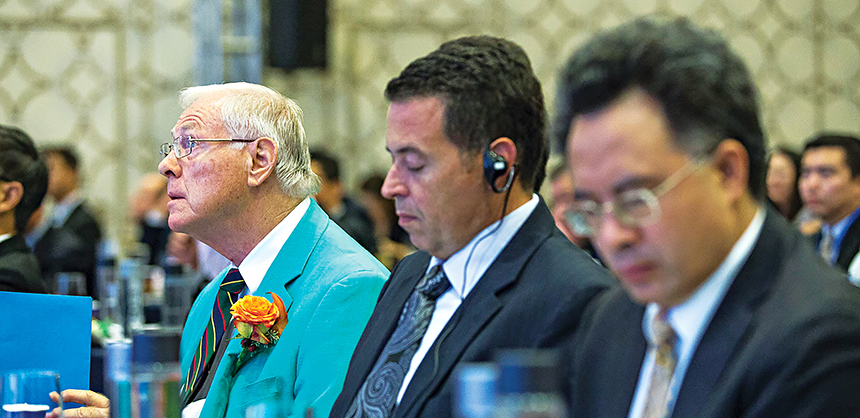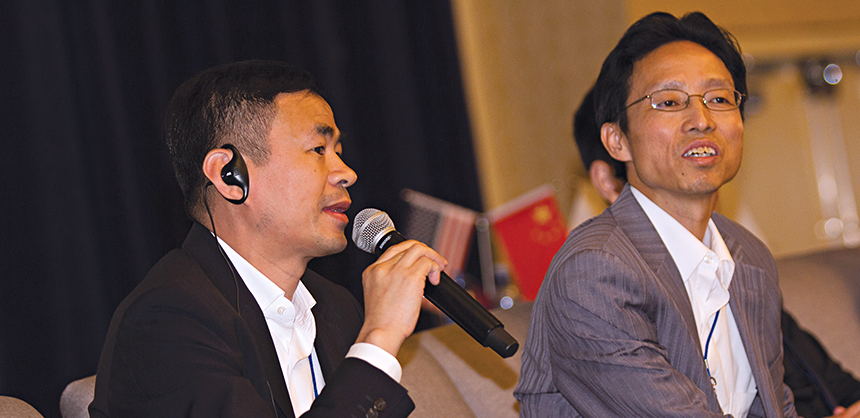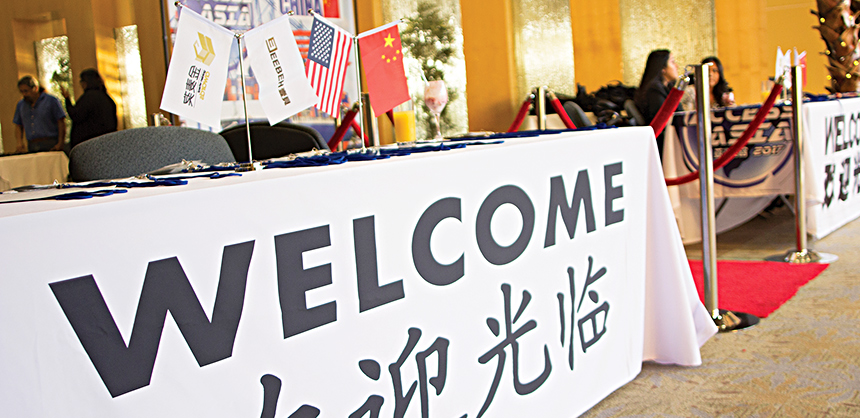Mind Your LanguageJune 26, 2023
Multilingual Considerations in Today’s Meetings By Maura KellerMind Your Language
Multilingual Considerations in Today’s Meetings
It is important to know what type of multilingual considerations need to be put in place prior to your meeting. Courtesy of Nikki Yep
The American melting pot consists of many ingredients. It’s what gives our nation depth, character and diversity. According to the Brookings Institute, studies indicate the annual population changes by race and ethnicity since 2016 show that the nation’s white population dropped in size. Thus, all of the U.S. population growth from 2016 to 2020 comes from gains in people of color. And the number of ethnic Americans will eventually represent the majority of the U.S. population. Despite this fact, some meeting planners continue to use a homogeneous approach to meetings and events while others are jumping on the proverbial “multicultural bandwagon.” But with so many different kinds of people boasting multicultural backgrounds and languages – corporate meeting and event planners need to incorporate multilingual elements into today’s meetings and events to establish an inclusive element to corporate gatherings.
“The world is getting smaller. Virtual options are allowing the world to collaborate more and more, crossing time zones, borders and even language barriers,” says Nikki Yep, chief operating officer and meeting planner at Event Solutions. “Effective communication and inclusion are two of the most important elements of today’s meetings and events. Meetings are especially important to have effective communication to ensure the goals are accomplished.”
There are key multilingual components that need to be included in all types of meetings and events. For example, as with all events, Yep and the team of meeting planners at Event Solutions first establish what multicultural attendees’ needs are. How many people need translator services and to what degree? What languages need to be included? Should all printed and online materials be translated? During Event Solutions’ recent Access Asia event, guests from all over the world required multiple translators for different languages. Specifically over 300 attendees from across the globe gathered at Pacific Palms Hotel in the City of Industry, CA.
“To keep the communication clear, we provided headsets. Translators worked from booths during the presentations and then were assigned to individuals during the breakout,” Yep says. “Signage was also provided in multiple languages to ensure that we provided an inclusive space for all guests.”
Cindy Lo, meeting planner and CEO of Red Velvet, says if you want to be more inclusive, you do need to offer either live translation or over-communicate what language(s) the sessions will be given in.
“Yes, it’s true that the default is English but I have been to American-company hosted events in other parts of the world where the attendees mostly do not speak English so it’s imperative to have a plan that works for these non-native English speakers,” Lo says. “And beyond language, I also would encourage the hard-of-hearing and blind.” Indeed, more and more planners are incorporating translation services for those who are unable to hear as well as accommodations for those with sight issues.
If you know in advance that your audience is a pretty evenly divided between native Spanish-speakers and English-speakers, Lo suggests proactively translating website, registration materials and any handouts/slides to both languages. She would then also have all of the sessions clearly marked on the agenda if they will be spoken in English, Spanish or even both.
“Incorporating multilingual components sets the foundation for a culture of inclusivity at the event, making those who speak different languages feel valued and welcome and encourages participation and collaboration among attendees,” says Sarah Buchbinder, meeting group broker at Meetings Made Easy. “It also reduces the possibilities of echo chambers and opens the dialogue to a more diverse set of contributions and feedback. You get what you give — by putting your message out to people of other languages and cultures, you’re going to get a wider range of input. The more diverse your attendees, the more distinct contributions you’ll receive.”
Buchbinder worked on a pharmaceutical event in Costa Rica, discussing use cases of a new treatment and how to focus it on where it’s most needed. The speakers included those who spoke English, Spanish and Portuguese.
“We had real-time interpreters in phone-booth-sized glass boxes in the rear of the room and I specifically remember one of the Spanish-Portuguese interpreters gesturing wildly and passionately during the speeches,” Buchbinder says. At the end of the meeting when the attendees were returning their headsets, so many commented about how engaging and captivating the presentation was because of this interpreter, and requested her contact information for their future events. What could have been a lost opportunity to reach these attendees, had there not been real-time translation, instead created a community even more engaged and committed.

Providing headphones that translate into your attendees’ native language is important for effective communication. Courtesy of Nikki Yep
Lost In Translation
The challenges of properly managed multilingual components of corporate events that may have attendees from many locations, who speak different languages, are certainly broad. The good news is that incorporating multilingual considerations is easier than it looks — and not always an expensive proposition.
To avoid embarrassing mistakes or potentially improper translation issues, Buchbinder stresses that meeting planners or their team members shouldn’t try to translate meeting components themselves. Rather, hire local translators because they are not only translating the content but the culture as well.
“There’s a reason the phrase ‘lost in translation’ exists, because you’re not just translating words, you’re interpreting a message,” Buchbinder says. “And being aware of cultural intricacies of the language and local interpretations can protect you from embarrassment or worse, misconceived messages. If you need examples of how this can go horribly wrong, just look at how Nikita Khrushchev almost started World War III, when Jimmy Carter expressed his ‘carnal desires’ for the Polish people [rather than what he meant – that he was happy to be in Poland], or more recently when Justin Trudeau mistakenly praised the ‘railroad stations in Motorola’ [due to speech recognition errors].”
Other translation tips that Buchbinder recommends include:
- Give your interpreters access to the speeches and topics with as much lead time as you can … First, for them to learn any industry or topic-specific verbiage, and second, to be able to review their interpretations and clarify any unclear idioms, phrases and messages. “While someone may be able to speak about their heart in French, they may not be familiar with the medical terminology surrounding a thoracic aortic dissection repair,” Buchbinder says.
- Hire registration and hospitality/information desk staff that are multilingual in as many of the languages of your attendees as you can. Having somewhere for an attendee to reach out to when they have questions will immediately make them feel like a valued guest and encourage their participation. Buchbinder studied to become fluent in Spanish and Portuguese, and it has proven invaluable when she is working onsite at a meeting to be able to assist a wider contingent of attendees, and communicate with local staff.
- Utilize a way to show what languages people speak when meeting others – what about lapel pins, ribbons, or even flags or colors on their name badges. This will not only foster networking but also acts as a conversations starter when meeting someone new.
- Incorporate translations both audially and visually using subtitles on presentations whenever possible.
Yep agrees that planners should consider the potential of content being lost in translation. If possible, she says it is a best practice to give the translator a script so they are aware of terms.
“If you forecast complicated terms and ideas, it is helpful to print out one sheet for guests so they can see the takeaway points in their native language,” Yep says.
Also, don’t make assumptions that everyone speaks the same language. When in doubt, ask.

Having legible signage in multiple languages is important. Courtesy of Nikki Yep
“Some people are able to understand written but struggle with speech. Some can understand spoken but struggle to speak the language themselves. Everyone benefits from effective communication, so it is well worth the consideration and effort,” Yep says.
Besides added costs being the biggest hurdle for most planning organizations (especially right now when companies are looking at every line item of the budget to cut), Lo suggests investing in a live translator vs. someone that will translate writing only.
“As far as mistakes to avoid as it relates to translation, the planner may not be sensitive to cultural differences and nuances in the language, or opt for low-quality or inaccessible translation services,” Buchbinder says. “If you’ve ever put something in Google translate and then tried to translate in a few different languages and then back to English, you’ll see why this is a bad idea.”
Also, not testing the audio equipment beforehand or not giving enough instruction in how to utilize it is a common mistake. Another is not communicating to attendees beforehand that there will be translation services or that there will be multilingual content. “You may lose attendees before you start if they don’t know they are going to be able to be understood,” Buchbinder says.
“And be sure to cover slang, as that has hurt us in the past. Something that is usually common slang in American English is considered offensive in some other languages,” Lo says.
Globalization Means Translation
The multicultural meetings and events attendee is becoming the mainstream attendee. As demographics in the U.S. continue to shift to make way for a new “minority majority,” multilingual experiences within the realm of meetings and events will continue to become more mainstream and reflect those in the rest of the world. As ethnic Americans quickly become a significant population segment, many meeting planners are realizing that the “one size fits all” technique for the events industry simply doesn’t work.
What’s more, with the rebound of meetings since the COVID pandemic and companies looking to globalize even more than before, multilingual considerations at meetings and events is paramount. Plus, as Buchbinder explains, the COVID-19 pandemic has accelerated the adoption of virtual and hybrid events, and increased the access to tools available to facilitate multilingual programs.
“These tools have become more cohesive and cost effective, giving planners more opportunity to reach a wider audience and have more successfully inclusive attendee experiences at their events,” Buchbinder says.
Lo is hoping one day, since most attendees have smart phones, that they can easily plug in a headset that takes the on-stage speaker’s amplified voice and automatically translate to the attendee’s preferred language.
“This would be the ideal situation – that way everyone can get the talk in their preferred native tongue and we don’t have to worry about noise pollution since everyone is able to tune into their own ‘frequency’ on their smart phone,” Lo says. “I think we’re very close to this type of solution as I already got to beta test something.” C&IT








